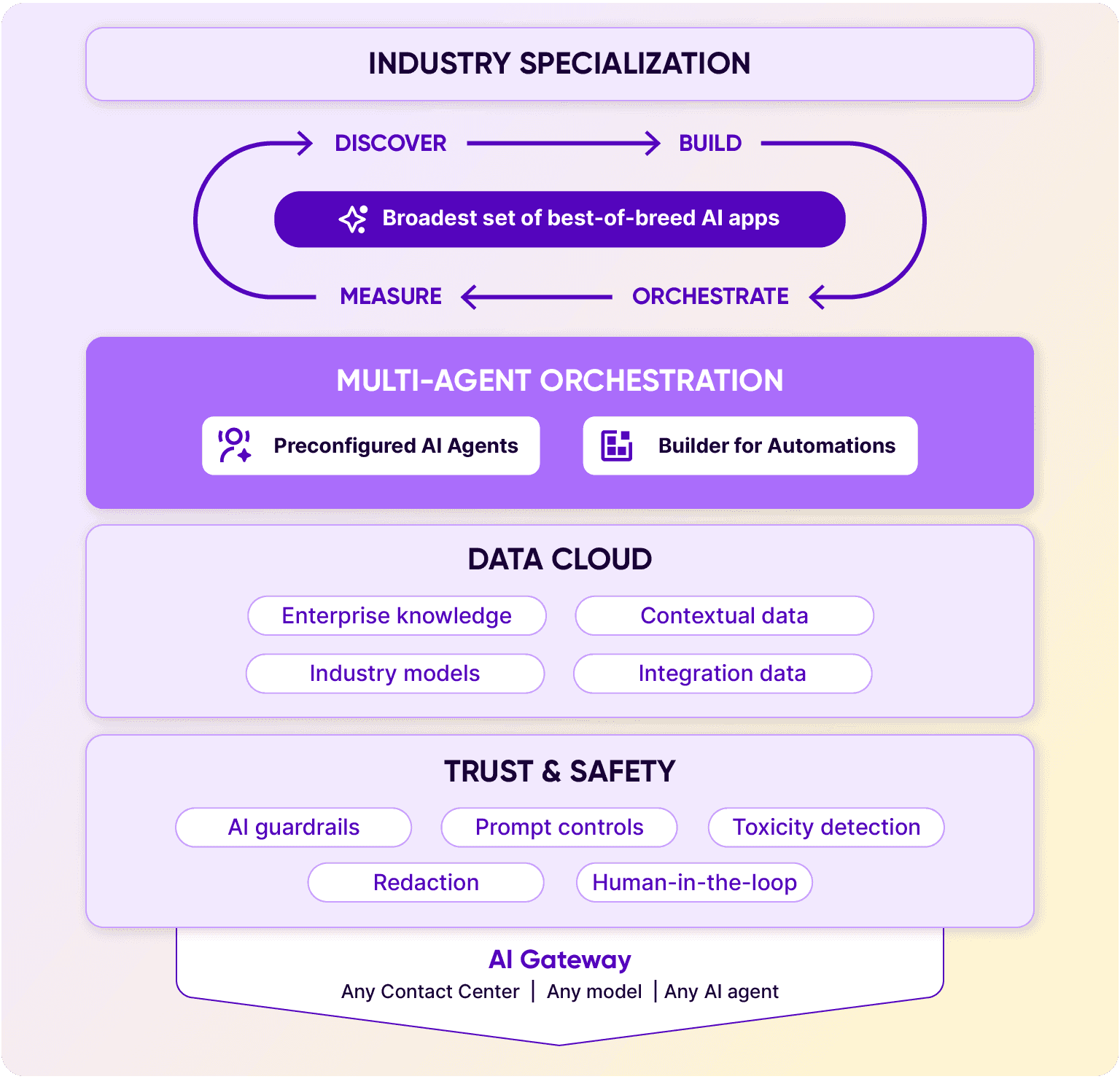Customer Experience Automation (CXA) in B2B SaaS starts with a data cloud

By Munil Shah
0 min read

Customer experience (CX) systems face a crucial challenge: delivering highly personalized, automated, real-time interactions on top of data that is fragmented, stale, and incomplete.
From an architectural standpoint, this is an unsolved problem in many B2B SaaS organizations. Data lives in CRMs, ticketing systems, knowledge bases, call transcripts, chat logs, and many other systems of record and interaction channels. Integration strategies have evolved from point-to-point APIs to middleware and iPaaS, but the core problem remains: the data is scattered, fragmented, and poorly contextualized for real-time use.
For IT teams trying to deploy AI-powered automation, whether chatbots, voice assistants, or multi-step workflows this fragmentation creates serious barriers. Models and rules are only as good as the data that supports them, and if they can’t access timely, consistent, and contextual information about a customer, they fall back to generic responses, frequent transfers, and fragile processes.
A data cloud for CX automation is a crucial architectural layer for enabling modern, agentic customer experience systems.
From data integration to data activation.
Moving data between systems is the goal of integration projects in B2B SaaS organizations, but this alone doesn’t solve the core challenge for customer experience automation. Data needs to be reliable, consistent, and structured to improve interactions and drive intelligent processes.
Agentic CX systems have different requirements. They need to reason over unified context in real time, such as:
-
Knowing that a customer called yesterday about a billing issue.
-
Accessing relevant notes and transcripts.
-
Understanding product usage history and preferences.
-
Merging data across channels.
However, connectivity alone isn’t enough. Activation is crucial to enable data to support automated reasoning and decision-making. A data cloud for CX automation provides this layer by unifying structured data (records, case metadata) and unstructured data (transcripts, notes) into a consistent, queryable, and real-time source of truth.
Core design requirements for a CX data cloud.
Designing a data cloud for CX automation goes well beyond conventional data warehousing. It requires real-time data capture and low-latency availability to support live AI workflows, along with the ability to handle both structured and unstructured data.
Contextualization is critical for converting raw inputs into actionable knowledge through techniques like entity extraction and alignment with industry-specific models. Equally important are consistency and governance features that ensure a single source of truth, enforce access controls, and meet regulatory requirements. Finally, interoperability is essential to enable seamless integration with existing systems and avoid vendor lock-in through standardized interfaces. These aren’t optional capabilities. Without them, any new platform risks recreating the same fragmented silos it was meant to replace.
The role of a data cloud in enabling automation.
A unified data layer shapes how organizations design, build, and execute automation by providing the essential data foundation for every stage of the process.
Discovery. Aggregated and normalized interaction data enables analytics to identify repetitive processes and complex customer journeys, providing the visibility needed to move beyond reactive and incomplete automation strategies.
Design and personalization. Workflows depend on detailed customer context to avoid generic, one-size-fits-all automation, and a data cloud delivers this context in real time to support more adaptive, tailored interactions.
Execution orchestration. For multi-step, multi-agent workflows, consistent data access is critical so that specialized agents performing sub-tasks can maintain shared understanding and avoid redundant questions or conflicting actions.
Measurement and optimization. Capturing interaction data and outcomes in a unified layer enables feedback loops that drive continuous improvement, supporting the training of machine learning models and the refinement of rule-based workflows.
A data cloud isn’t an optional component for automation—it’s an enabler, allowing orchestration layers and AI agents to move beyond scripted behavior and toward genuinely adaptive, context-aware interaction.
Architectural placement.
Data cloud serves as the foundational layer in the CX technology stack:
-
It sits below orchestration engines that manage workflows and agent coordination.
-
It interfaces with systems of record, collecting and aligning data.
-
It supports the automation and AI layers by providing timely, consistent, and contextual information.
Unlike traditional data lakes or warehouses that prioritize batch analytics, a data cloud for CX B2B SaaS organizations must meet certain requirements such as low latency, high availability, real-time updates, or APIs that serve live interaction contexts. This, in turn, places constraints on the architecture, such as event-driven pipelines, scalable storage optimized for mixed data types, and robust API layers.
Business implications and value of a data cloud.
While this might seem like an infrastructure concern at first glance, the business implications are significant and far-reaching. A data cloud purpose-built for customer experience does more than just store information, it is the backbone for operational excellence and competitive differentiation. It empowers organizations to transform how they engage with customers and deliver value at every touchpoint. Specifically, the right data architecture unlocks:
-
Seamless scalability. A centralized, real-time data foundation enables automation to extend beyond isolated tasks into broader operations, such as customer service, sales, and back-office.
-
Accelerated AI agent deployment. Rich, structured data enables faster training and deployment of AI agents for new business needs and industries without duplicating integrations or logic.
-
Improved resolution rates. Agents, human or automated, can access the complete, current context to resolve issues without unnecessary escalation.
-
Reduced operational costs. More processes can be reliably automated, freeing human agents to focus on exceptions and complex interactions.
-
Faster time to market for automation. Unified data enables faster identification of automation opportunities and simpler workflow design.
-
Improved customer satisfaction and retention. Personalization, consistency, and reduced friction directly impact NPS, customer satisfaction, and churn.
For IT leaders, the value proposition is clear: a data cloud for CX automation shifts data strategy from a back-office cost center to a driver of customer value and competitive differentiation.
The Talkdesk Data Cloud.
These concepts aren’t theoretical. At Talkdesk, we recognized these requirements and built the Talkdesk Data Cloud to address them natively. Our data cloud is a unified data layer designed specifically for customer experience automation (CXA). Architecturally, it sits below our multi-agent orchestration layer, ensuring that specialized AI agents, each focused on a particular task, have access to the same consistent, contextual customer view. This coordination enables real-time automation of complex workflows without losing continuity or context.
Critically, it’s not a generic warehouse or an add-on integration. It’s built-in, supporting industry-specific models for domains like healthcare, retail, and financial services, and designed to interoperate with existing systems of record without locking customers into a single vendor stack.

Rethinking data strategy for CX automation.
As a technology leader, it’s worth asking: is your current data architecture prepared to support the level of automation and AI your customer experience strategy requires? Do your systems have access to real-time, contextual, consistent data or are they making decisions in the dark?
Moving to a unified data cloud model is not a trivial investment. It requires rethinking pipelines, integration patterns, governance, and security. But without it, even the most advanced AI and automation strategies will fall short.
At Talkdesk, our approach to the data cloud implements these principles to help organizations move from fragmented data to connected, actionable customer knowledge. If you’re interested in learning more about how a purpose-built data cloud can support your CX automation strategy, our team would be happy to discuss your architecture goals and challenges. Let’s talk!






